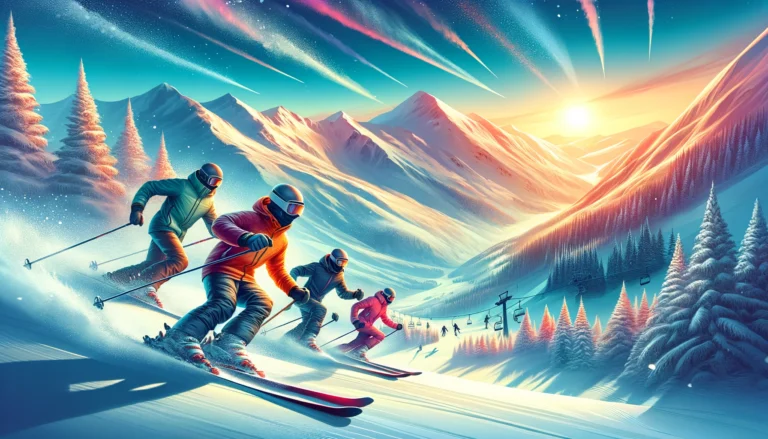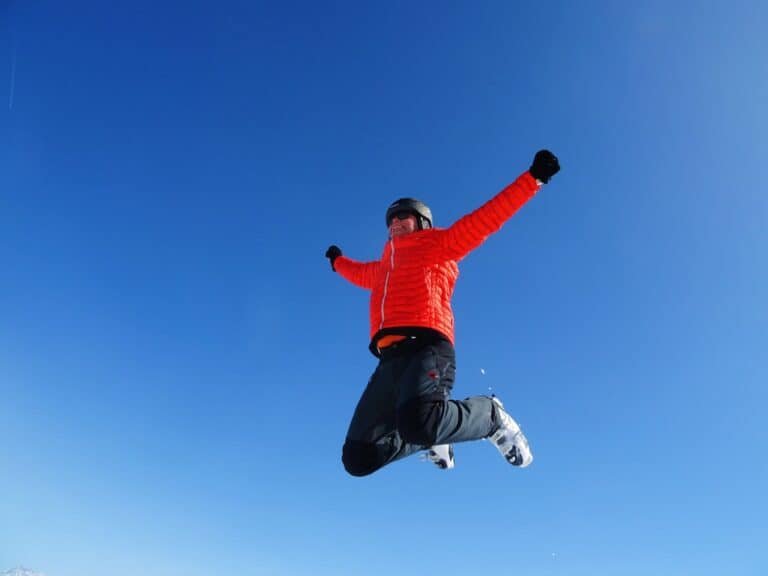Ski Buying Guide: Choose The Right Ski Waist Width
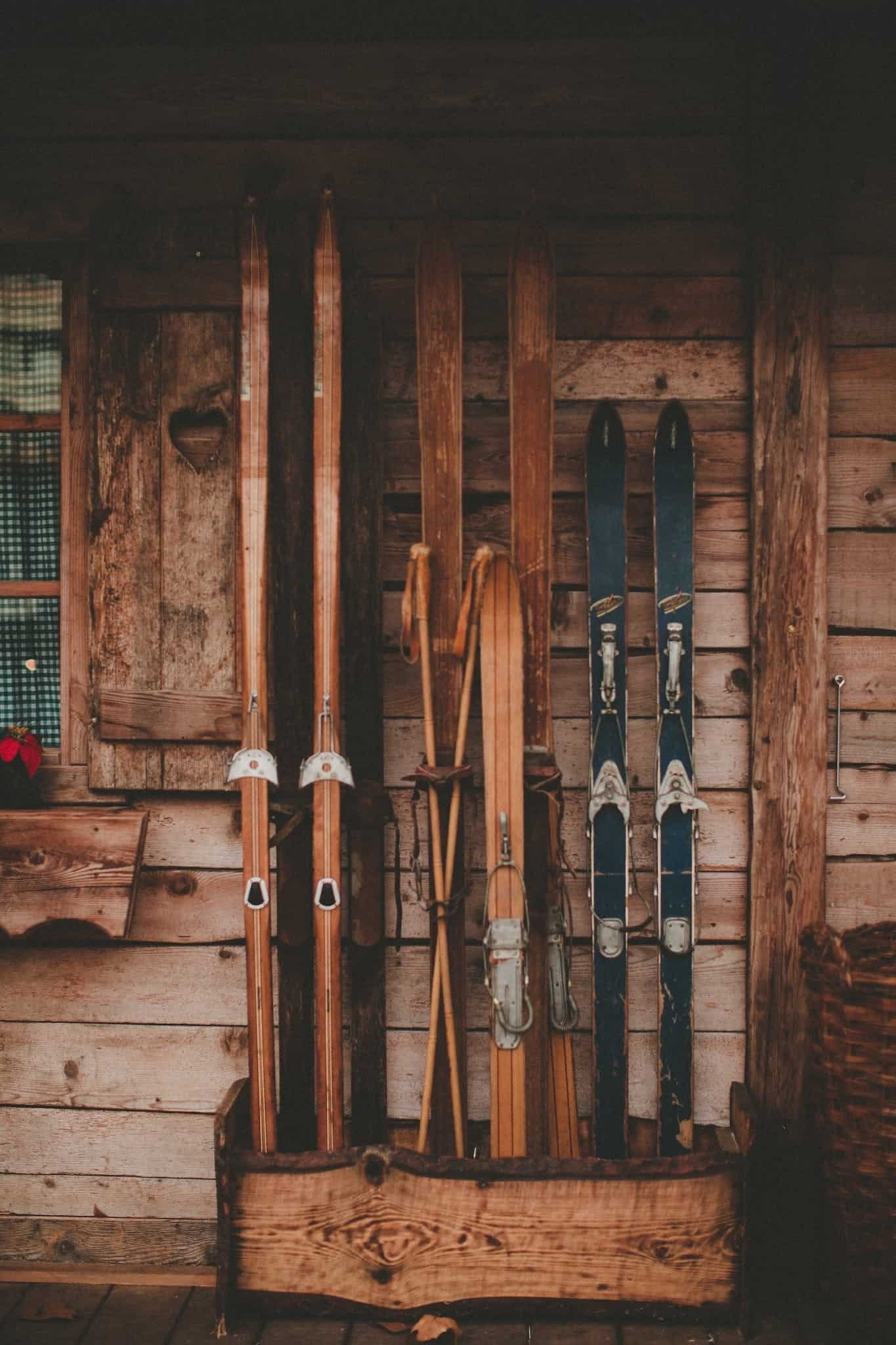
Welcome to your go-to guide to ski waist width, a crucial yet often overlooked factor that significantly influences your skiing experience. The waist width of a ski is the measurement of the ski’s narrowest point, usually located under your boot. This seemingly simple number can drastically affect how your skis perform on different terrains, whether you’re carving on groomed trails or floating through deep powder.
This article provides you with a comprehensive, well-researched, and experienced-backed guide on how to choose the right ski waist width. We’ll delve into various factors and skiing styles to ensure you make an informed decision tailored to your needs. We summarized the categories and made a ski waist widths table if you wanna jump right off it.
So, whether you’re a beginner looking to hit the slopes for the first time or an experienced skier seeking to optimize your gear, read on to find your ideal ski fit.
Key Takeaways:
- Ski waist width, measured in millimeters at the ski’s narrowest point, significantly affects a ski’s performance across different terrains and snow conditions. It’s crucial to choose a waist width aligned with your skiing style, skill level, and typical skiing conditions.
- Various categories of ski waist width cater to different skiing preferences, from narrow skis ideal for carving and racing, to wider skis suited for powder, big-mountain, and backcountry skiing.
- Modern technologies like Carbon Fiber Construction, Titanal Layers, and Rocker-Camber-Rocker profiles have enhanced ski performance across all waist widths, making wide skis more versatile for all-mountain use.
- Investing time in understanding ski waist width, trying different skis, consulting with experts, and considering your skiing preferences will contribute to a more enjoyable and fulfilling skiing experience. Making an informed decision on ski waist width sets the stage for rewarding skiing adventures ahead.
What is Ski Waist Width?
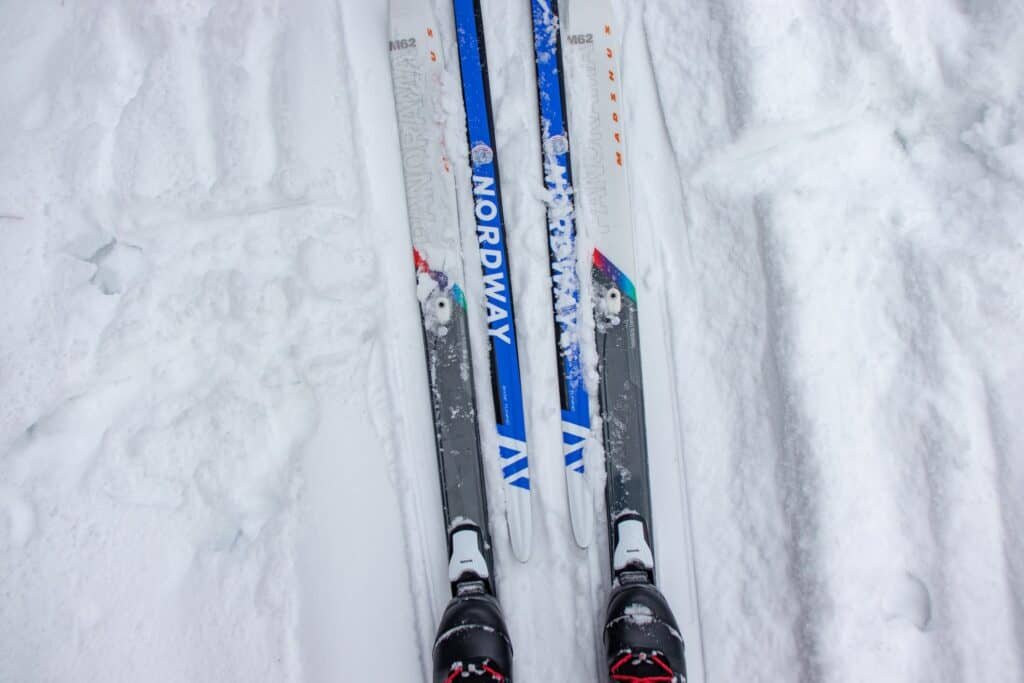
Ski waist width refers to the measurement of a ski at its narrowest point, typically located directly under the boot. This measurement is usually expressed in millimeters and is a critical specification you’ll encounter when shopping for skis. But why is this number so important?
When we talk about ski waist width, it’s essential to understand that this measurement is just one of three critical dimensions that describe a ski’s geometry. These dimensions are often listed as a series of three numbers, such as 120-80-110, representing the ski’s tip width, waist width, and tail width, respectively, all measured in millimeters.
How It’s Measured
The waist width is measured across the ski’s narrowest point, usually located directly under the boot. This measurement is taken in millimeters using specialized calipers to ensure accuracy. It’s crucial to note that even a few millimeters can make a noticeable difference in how a ski performs.
Sidecut Radius
The difference between the tip, waist, and tail widths also determines the ski’s sidecut radius, which is the imaginary circle that would be made if the curve of the ski’s edge were extended into a full circle. A smaller sidecut radius indicates a ski designed for tighter turns, while a larger radius suggests a ski built for long, sweeping turns. The waist width plays a significant role in determining this radius.
Variability in Models
Different models of skis may have varying waist widths to cater to specific types of skiing. For example, an alpine ski may have a narrow waist for quick, sharp turns, while a powder ski may have a much wider waist to provide better flotation in deep snow.
Why do millimeters Matter?
In the world of skiing, millimeters can make a world of difference. A ski that is just 5mm wider at the waist can significantly alter your experience, affecting everything from turn initiation to stability in varying snow conditions. Therefore, it’s essential to consider the exact waist width, not just a general range, when selecting your skis.
Significance in skiing
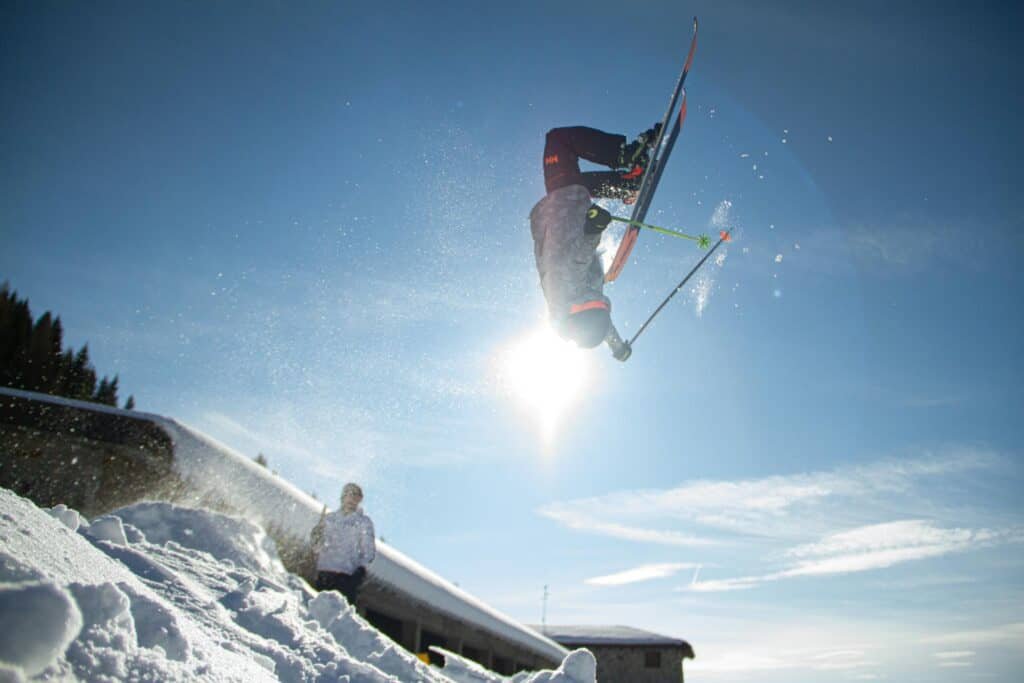
The waist width can influence how well the ski performs on different types of snow and terrain. Narrower skis (usually less than 80mm) are agile and excel on groomed runs, making them ideal for carving. On the other hand, wider skis (above 100mm) offer better flotation in powder conditions, allowing you to glide effortlessly on deep snow.
The waist width also affects how much control you have over your skis. Narrow skis offer better edge control, making it easier to make quick turns. Wider skis provide more surface area, which can be beneficial for stability, especially in softer snow conditions.
Lastly, the waist width impacts the ski’s maneuverability. Narrower skis are generally easier to turn and navigate through tight spaces, such as tree lines. Wider skis, while excellent for floating on powder, may be less agile and require more effort to initiate turns.
Ski Categories and The Ideal Waist Width
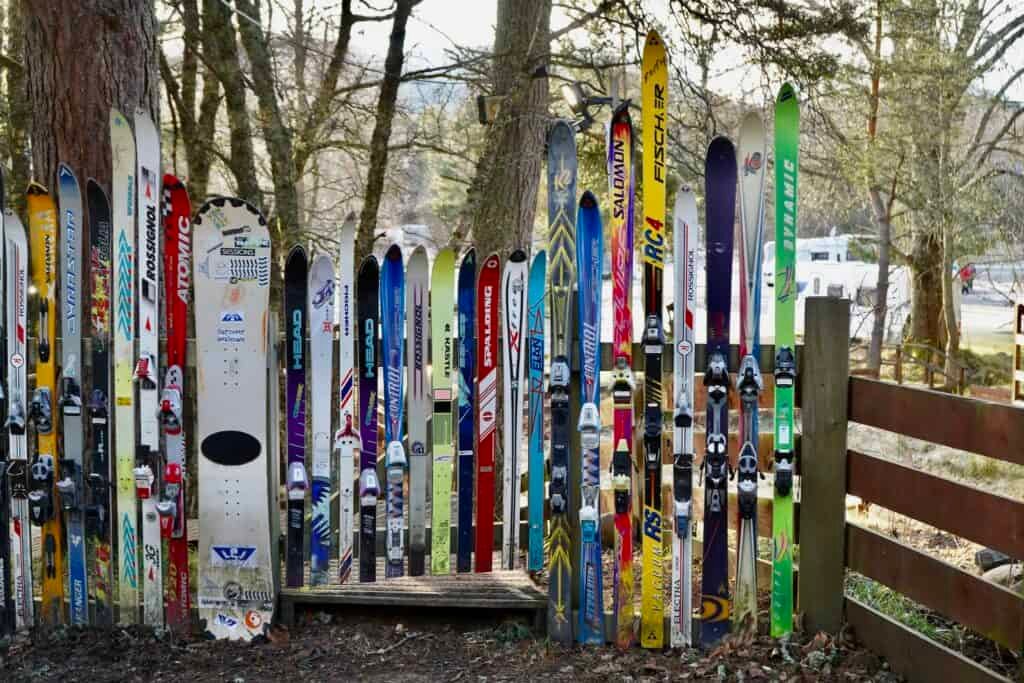
In terms of waist width, there is a lot of common ground, but the range for all-mountain skis, powder skis, etc., can vary significantly between manufacturers and retailers. For instance, some retailers may use a waist width range of 85-95 mm for all-mountain skis, while others may use a range of 85-110 mm. So I spoke with different local skiers, and some outdoor stores and did thorough research to come up with a good guide waist width range for different types of skis.
For a summary, we categorized the ski waist widths in this table, according to various skiing styles and preferences, but below you will find the detailed breakdown of each category.
| Category | Waist Width Range (mm) | Primary Focus | Ideal Users | Terrain Suitability | Examples |
|---|---|---|---|---|---|
| Racing | Less Than 70mm | Speed and precision on groomed racing courses | Competitive racers; Advanced skiers seeking high-speed carving on groomed trails | Groomed racing courses, hard-packed snow | Atomic Redster S9, Fischer RC4 Worldcup SC |
| Beginners | Around 70-85mm | Learning and progressing in skiing with ease and control | Novice skiers; Those building confidence on groomed trails | Groomed trails, gentle slopes | Rossignol Experience 76 CI, Salomon QST 85 |
| Carving | Less than 82mm | Carving and on-piste skiing | Beginners finding their balance and edging; Advanced skiers who love carving or race-oriented skiing | Groomed trails and hard-packed snow | Volkl Deacon 76, Head Supershape e-Magnum |
| All-Mountain | 82-102mm | Versatility across various terrains and snow conditions | Intermediate to advanced skiers looking for versatility; Skiers who explore a mix of groomed trails, off-piste, and occasional powder | Groomers, bumps, off-piste back bowls, trees | Blizzard Brahma 82, Elan Ripstick 88, Faction Prodigy 2 |
| Big-Mountain / Freeride | 102-112mm | Tackling steeper, deeper, and more variable terrain | Advanced to expert skiers seeking off-piste challenges; Skiers who prefer steeper terrains and deeper snow | Steep off-trail terrains, deep snow | Black Crows Atris, Dynastar M Free 108 |
| Powder | 112mm+ | Maximizing flotation and control in deep snow | Powder hounds who seek the deepest snow; Skiers in regions with frequent heavy snowfall | Powder, soft snow, and off-piste | Nordica Enforcer 104 Free, Line Blade Optic 104 |
| Backcountry/Ski Touring | 90-110mm | Exploring ungroomed and natural terrains away from resort boundaries | Experienced skiers with good knowledge of backcountry safety; Those seeking solitude and untouched snow terrains | Ungroomed trails, alpine touring, mixed snow conditions | Black Crows Camox Freebird, Dynafit Beast 98 |
1. Racing: Narrow Waist Widths (Less Than 70mm)
- Primary Focus: Speed and precision on groomed racing courses.
- Performance Characteristics:
- Narrow waist widths (less than 70mm) for rapid edge transitions and optimal grip on hard snow.
- Stiff flex for stability at high speeds and aggressive carving.
- Ideal Users:
- Competitive racers.
- Advanced skiers seeking high-speed carving on groomed trails.
- Terrain Suitability: Groomed racing courses, hard-packed snow.
- Examples: Atomic Redster S9, Fischer RC4 Worldcup SC.
2. Beginners: Narrow To Medium Waist Widths (Around 70-85mm)
- Primary Focus: Learning and progressing in skiing with ease and control.
- Performance Characteristics:
- Narrow to medium waist widths (around 70-85mm) for easier maneuverability and control.
- Softer flex for a forgiving nature and ease of turning.
- Ideal Users:
- Novice skiers learning the basics of skiing.
- Those building confidence on groomed trails.
- Terrain Suitability: Groomed trails, gentle slopes.
- Examples: Rossignol Experience 76 CI, Salomon QST 85.
3. Carving: Narrow Waist Widths (Less than 82mm)
- Primary Focus: Carving and on-piste skiing.
- Performance Characteristics:
- Quick edge-to-edge transitions facilitate tight carving turns.
- Excellent grip on hard, groomed, or icy conditions.
- Ideal Users:
- Beginners finding their balance and edging.
- Advanced skiers who love carving or race-oriented skiing.
- Terrain Suitability: Groomed trails and hard-packed snow.
- Examples: Volkl Deacon 76, Head Supershape e-Magnum.
4. All-Mountain: Medium Waist Widths (82-102mm)
- Primary Focus: Versatility across various terrains and snow conditions.
- Performance Characteristics:
- Balanced performance in both carving and floating over soft snow.
- Good maneuverability and stability.
- Ideal Users:
- Intermediate to advanced skiers looking for versatility.
- Skiers who explore a mix of groomed trails, off-piste, and occasional powder.
- Terrain Suitability: Groomers, bumps, off-piste back bowls, trees.
- Examples: Blizzard Brahma 82, Elan Ripstick 88, Faction Prodigy 2.
5. Big-Mountain / Freeride: Wide Waist Widths (102-112mm)
- Primary Focus: Tackling steeper, deeper, and more variable terrain.
- Performance Characteristics:
- Better flotation in deeper snow while retaining some versatility.
- More suited for off-trail and soft snow conditions.
- Ideal Users:
- Advanced to expert skiers seeking off-piste challenges.
- Skiers who prefer steeper terrains and deeper snow.
- Terrain Suitability: Steep off-trail terrains, deep snow.
- Examples: Black Crows Atris, Dynastar M Free 108.
6. Powder: Extra Wide Waist Widths (112mm+)
- Primary Focus: Maximizing flotation and control in deep snow.
- Performance Characteristics:
- Exceptional flotation in deep snow.
- Sluggish edge-to-edge transitions on hardpack, but stable in powder.
- Ideal Users:
- Powder hounds who seek the deepest snow.
- Skiers in regions with frequent heavy snowfall.
- Terrain Suitability: Powder, soft snow, and off-piste.
- Examples: Nordica Enforcer 104 Free, Line Blade Optic 104.
7. Backcountry/Ski Touring: Moderate Waist Width ( 90-110mm)
- Primary Focus: Exploring ungroomed and natural terrains away from resort boundaries.
- Performance Characteristics:
- Lightweight for uphill efficiency, with varying widths to balance between uphill performance and downhill capabilities.
- Moderate waist widths (around 90-110mm) provide a good balance of flotation in softer snow and efficiency on the ascent.
- Ideal Users:
- Experienced skiers with good knowledge of backcountry safety.
- Those seeking solitude and untouched snow terrains.
- Terrain Suitability: Ungroomed trails, alpine touring, mixed snow conditions.
- Examples: Black Crows Camox Freebird, Dynafit Beast 98.
The Ski Waist Width Factors to Consider
Selecting the right ski waist width is a tricky decision that involves various factors. Understanding how each factor impacts the ideal waist width for you can significantly improve your skiing experience. Below are the detailed considerations that come into play:
1. Personal Skiing Style, Skill Level, and Terrain Preferences
- Skiing Style:
- Carving: If you enjoy carving tight turns on groomed trails, a narrower waist width is usually more suitable as it allows for quicker edge-to-edge transitions.
- Off-Piste: For off-piste adventures, a wider waist width provides better flotation on soft snow and can handle varied terrain better.
- Freestyle: Freestyle skiers might prefer a medium to wide waist width for a balanced performance between carving and flotation, depending on the terrain they frequent.
- Skill Level:
- Beginner: Beginners may find narrower waist widths easier to handle and control, aiding in learning the basics of skiing.
- Intermediate to Advanced: As skill level advances, skiers might lean towards wider skis for off-piste skiing or stick to medium waist widths for all-mountain versatility.
- Terrain Preferences:
- Your preferred skiing terrain significantly impacts the ideal waist width. If you ski primarily on groomed trails, a narrower ski is typically better, while off-piste and powder terrains call for wider skis.
2. Height and Weight Considerations
- Your body dimensions play a crucial role in finding the ideal ski waist width:
- Taller and Heavier Skiers: May benefit from wider skis that provide better support and stability.
- Shorter and Lighter Skiers: Might find narrower skis more maneuverable and responsive.
3. Geographic Location and Typical Snow Conditions Encountered
- Location:
- Eastern Regions: Typically have icier and harder snow conditions, making narrower skis with better edge grip a preferable choice.
- Western Regions: Often have softer snow conditions, making wider skis a more suitable choice for better flotation and stability.
- Snow Conditions:
- Powder: Wider skis are preferable for powder conditions as they provide better flotation.
- Hardpack: Narrower skis are better suited for hardpack conditions as they provide better edge grip for carving.
- Seasonal Variations:
- The snow conditions you encounter may vary seasonally, and having a ski that matches the typical conditions of your skiing season is crucial for an enjoyable skiing experience.
What Affects Ski Performance?

While waist width is a critical factor in determining how a ski performs, it doesn’t operate in isolation. Several other elements, such as flex, dampness, and ski profile, work in tandem with waist width to influence your overall skiing experience. Understanding these factors can help you make a more informed decision when choosing the right pair of skis.
Flex
Flex refers to the stiffness or softness of a ski and is usually rated on a scale from soft to stiff. The flex of a ski can significantly impact its performance in different terrains:
- Soft Flex: Skis with a softer flex are generally more forgiving and easier to turn, making them ideal for beginners and intermediate skiers. They perform well in softer snow conditions and are more maneuverable in tight spaces like tree runs.
- Stiff Flex: Stiffer skis offer more stability at high speeds and are better suited for advanced skiers who prefer aggressive skiing. They excel in hard-packed snow and icy conditions, providing better edge grip.
Dampness
Dampness refers to a ski’s ability to absorb vibrations and provide a smooth ride. Skis with high dampness levels are often constructed with materials like metal laminates or rubber layers to reduce chatter, especially at higher speeds:
- High Dampness: Skis with high dampness offer a smoother, more stable ride but may sacrifice some level of responsiveness. They are excellent for skiing at high speeds on hard-packed or icy terrains.
- Low Dampness: Skis with low dampness levels are more lively and responsive but may feel chattery on rough terrains. They are generally better for softer snow conditions and for skiers who prefer a more tactile feel underfoot.
Ski Profile
The ski profile, which includes the camber and rocker, plays a crucial role in how a ski performs:
- Camber: This is the upward curve in the middle of the ski when it lays flat on the ground. Camber provides a better edge grip on hard snow and enhances carving ability. It offers more pop and energy in turns but may be less forgiving in softer snow conditions.
- Rocker: Also known as reverse-camber, rocker is the upward curve at the tip and/or tail of the ski. It improves floatation in powder and makes the ski more maneuverable. However, too much rocker can reduce edge grip on hard snow.
Tips for Choosing the Right Waist Width
Selecting the right waist width for your skis is a critical factor in ensuring an enjoyable and effective skiing experience. Here are some practical tips to help you make an informed decision:
1. Try Different Ski Widths on a Demo Day:
- Participating in a demo day at a local ski resort allows you to try different ski widths and styles.
- Feeling the difference in performance between various waist widths on snow can provide valuable insights into what suits you best.
- It’s a hands-on way to understand how different waist widths affect your skiing experience.
2. Consider Your Skiing Preferences and Usual Ski Locations:
- Reflect on the type of skiing you enjoy most – whether it’s carving on groomed trails, exploring off-piste terrains, or floating on powder.
- Also, consider where you usually ski – the typical snow conditions and terrains at your usual skiing locations can guide you toward a suitable waist width.
3. Consult with Skiing Experts:
- Ski professionals and instructors can provide personalized advice based on your skiing style, skill level, and the typical conditions you ski in.
- They can help you understand the technical specifications and how different waist widths will perform in various conditions.
4. Review Ski Specifications:
- Delve into the specifications of various skis, paying particular attention to the waist width, but also considering other factors like the ski’s profile, flex, and length.
- Reading reviews and comparisons can also provide useful insights.
5. Don’t Rush the Decision:
- Take your time in making a decision. It’s an investment that affects your skiing experience significantly.
- It may also be beneficial to rent different skis to try them out in various conditions before making a purchase.
Technologies Enhancing Ski Performance Across Widths
The evolution of skiing technology has significantly improved ski performance across various waist widths. New technologies, in particular, are making wide skis more versatile for all-mountain use. Here’s a closer look at some of these technologies and how they contribute to skiing performance:
1. Carbon Fiber Construction:
- Description: Utilizing carbon fiber in ski construction reduces weight while maintaining strength and rigidity.
- Impact: Makes wide skis easier to maneuver and control, enhancing performance both on and off-piste.
2. Titanal Layers:
- Description: Titanal, a type of aluminum alloy, is used in layers to add strength and dampening properties to skis.
- Impact: Increases stability at high speeds and smooths out the ride, making wide skis more versatile across various terrains and conditions.
3. Rocker-Camber-Rocker Profile:
- Description: This profile features a cambered section underfoot for edge grip on hard snow, with rockered tips and tails for better floatation in powder.
- Impact: Enhances the all-around performance of wide skis, providing a balance between carving ability and floatation.
4. Tapered Tips and Tails:
- Description: Tapering the tips and tails reduces swing weight and improves maneuverability.
- Impact: Makes turning and maneuvering easier, especially in tight situations or in softer snow conditions.
5. Hollowtech Technology:
- Description: Hollowtech technology involves hollowing out the tips of the skis, reducing weight and vibrations.
- Impact: Provides better stability, control, and shock absorption, especially at high speeds or on rough terrains.
6. Vibration Dampening Systems:
- Description: Various systems are employed to dampen vibrations, such as rubber layers or specific core constructions.
- Impact: Reduces chatter and improves the smoothness of the ride, aiding in better control and comfort on wide skis across different conditions.
7. Progressive Sidecuts:
- Description: Progressive sidecuts feature a combination of different sidecut radii along the length of the ski, improving turn initiation and performance.
- Impact: Enhances the carving ability and overall maneuverability of wide skis, making them more adaptable to varied mountain conditions.
8. 3D Radius Technology:
- Description: 3D radius technology combines a long radius in the ski’s center with shorter radii at the tip and tail, allowing for a variety of turn shapes.
- Impact: Provides a more versatile turning experience, making wide skis adaptable to both long and short turns based on skier input.
Ski Recommendations
The 2023-2024 ski season is coming up soon, so it’s time to find the right skis. Here are some suggestions for skis that will make your winter fun.
Racing: Blizzard Phoenix R14 Pro
Beginners: Atomic Bent 85 w/M10 GW Bindings
All-Mountain: Atomic Maven 86 Skis + M10 GW Bindings 2024
Big-Mountain / Freeride: Volkl Revolt 114
Powder: Nordica Enforcer 104 Free 2024
Backcountry/Ski Touring: Blizzard Zero G 105 Skis 2024, Salomon QST 98
Conclusion
Understanding ski waist width is a crucial step toward optimizing your skiing experience. The waist width significantly impacts the ski’s performance across different terrains and snow conditions. We’ve explored the various categories of ski waist widths, from narrow skis suited for carving and racing, to wider skis designed for powder, big-mountain, and backcountry skiing. The right waist width for you hinges on multiple factors including your skiing style, skill level, and the typical conditions you ski in.
Moreover, modern technological advancements have significantly enhanced ski performance across all waist widths, making wide skis more versatile for all-mountain use. Technologies like Carbon Fiber Construction, Titanal Layers, and Rocker-Camber-Rocker profiles, among others, contribute to better maneuverability, stability, and control, regardless of ski width.
Investing time to understand these nuances, trying different ski widths, consulting with experts, and considering your skiing preferences will pay dividends on the slopes. It’s well worth the effort to find the ski waist width that aligns with your skiing aspirations. By making an informed decision, you’re setting the stage for many enjoyable and rewarding skiing adventures ahead. So, delve into the details, try different skis, and get ready to enhance your skiing experience manifold!
FAQs
How do you read ski width?
Ski width is typically measured in millimeters and is often expressed in three numbers representing the tip, waist, and tail dimensions of the ski, in that order. For example, a ski with dimensions listed as 130-90-115 has a tip width of 130mm, a waist width of 90mm, and a tail width of 115mm.
What does ski width underfoot mean?
Ski width underfoot refers to the width of the ski at its narrowest point, which is usually located directly under the skier’s foot. This measurement is crucial as it significantly impacts the ski’s performance, including its turning capabilities and how well it can handle different snow conditions.
What does R mean in skis?
The “R” in skis typically refers to the radius of the ski, or more specifically, the sidecut radius. The sidecut radius is the measure of how deeply or shallowly the ski’s edges curve in from the tip to the waist and back out to the tail, and it gives an indication of the ski’s turning characteristics; a smaller radius indicates tighter turns, while a larger radius suggests longer, more sweeping turns.

